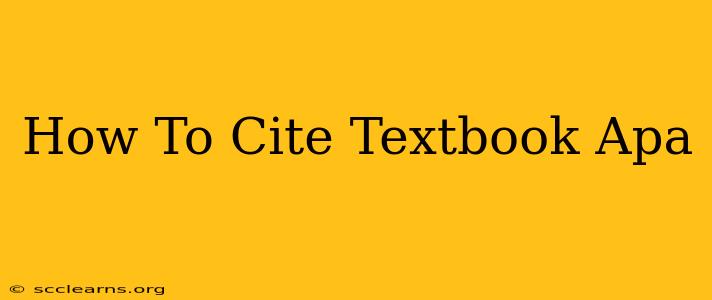Citing sources correctly is crucial for academic integrity. When it comes to citing textbooks in APA style, understanding the specific formatting requirements is essential to avoid plagiarism and demonstrate your research rigor. This guide provides a comprehensive overview of how to cite textbooks in APA 7th edition, covering various scenarios and offering helpful tips.
Understanding the Basics of APA Textbook Citations
The core components of an APA textbook citation include the author(s), publication year, title, edition (if not the first), publisher, and location. The format emphasizes brevity and clarity, making it easy for readers to locate the source.
Key Elements of an APA Textbook Citation:
-
Author(s): List the author's last name and initials. If there are multiple authors, separate them with commas and use an ampersand (&) before the last author's name. For more than 20 authors, list the first 19, then add an ellipsis (...) and the last author.
-
Year of Publication: This is usually found on the copyright page of the book.
-
Title: The title of the textbook should be italicized. Capitalize only the first word of the title and subtitle (unless it's a proper noun).
-
Edition: If it's not the first edition, indicate the edition number (e.g., 2nd ed.).
-
Publisher: The name of the publishing company.
-
Location: Usually the city and state (or country) where the publisher is located.
How to Cite a Textbook in APA: Examples
Let's look at some examples to illustrate how to cite different types of textbooks in APA style:
Example 1: One Author
Author, A. A. (Year). Title of work. Publisher.
Example:
American Psychological Association. (2020). Publication manual of the American Psychological Association (7th ed.). American Psychological Association.
Example 2: Two Authors
Author, A. A., & Author, B. B. (Year). Title of work. Publisher.
Example:
Smith, J., & Jones, D. (2022). Introduction to Psychology. Pearson.
Example 3: Three or More Authors
Author, A. A., Author, B. B., & Author, C. C. (Year). Title of work. Publisher.
Example:
Brown, K., Davis, M., & Wilson, S. (2023). Advanced Statistics. Routledge.
Example 4: Edited Book
Editor, A. A. (Ed.). (Year). Title of work. Publisher.
Example:
Johnson, R. (Ed.). (2021). Theories of Cognitive Development. Oxford University Press.
Example 5: Textbook with a Specific Chapter
When citing a specific chapter from a textbook, follow this format:
Author, A. A., & Author, B. B. (Year). Chapter title. In A. A. Editor & B. B. Editor (Eds.), Book title (pp. pages). Publisher.
Example:
Smith, J., & Jones, D. (2022). Chapter 3: Understanding Memory. In J. Smith & D. Jones (Eds.), Introduction to Psychology (pp. 50-75). Pearson.
In-Text Citations for Textbooks
When referencing a textbook within the body of your paper, use an author-date citation. If you're directly quoting, include a page number.
Examples:
- Paraphrase: (Smith & Jones, 2022).
- Direct Quote: "The process of memory involves encoding, storage, and retrieval" (Smith & Jones, 2022, p. 60).
Tips for Accurate APA Textbook Citations
- Double-check the details: Always verify the information against the textbook's title page and copyright page.
- Use a citation management tool: Tools like Zotero or Mendeley can help you manage and format your citations efficiently.
- Consistency is key: Maintain consistent formatting throughout your paper.
- Consult the APA Publication Manual: The official manual provides the most up-to-date guidelines.
By following these guidelines, you can accurately cite textbooks in APA style, demonstrating academic integrity and professionalism in your work. Remember, proper citation is crucial for avoiding plagiarism and strengthening the credibility of your research.

